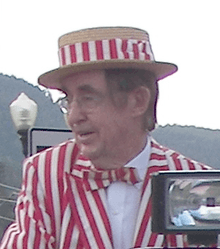Jerry Haynes
Jerome Martin "Jerry" Haynes (January 31, 1927 – September 26, 2011) was an American actor from Dallas, Texas. He is most well known as Mr. Peppermint, a role he played for 30 years as the host of one of the longest-running local children's shows in television, the Dallas-based Mr. Peppermint (1961–1969), which was retitled Peppermint Place for its second run (1975–1996). He also had a long career in local and regional theater and appeared in more than 50 films. A 1944 graduate of Dallas' Woodrow Wilson High School,[1] he was the father of Butthole Surfers frontman Gibby Haynes.[2][3]
Jerry Haynes | |
|---|---|
 Jerry Haynes, dressed as Mr. Peppermint, participating in Red River, New Mexico 4th of July parade | |
| Born | Jerome Martin Haynes January 31, 1927 Dallas, Texas, U.S. |
| Died | September 26, 2011 (aged 84) |
| Occupation | Actor |
| Years active | 1961–2009 |
| Spouse(s) | Doris |
| Children | Gibby Haynes |
Early life
He was born in Dallas, Texas to Louise Schimmelpfennig Haynes and Fred Haynes.[4] In 1990, Haynes was inducted into Woodrow Wilson High School's Hall of Fame.[1] Jerry graduated from Southern Methodist University after attending Louisiana State University and Yale.
Family
Jerry was father of Butthole Surfers frontman, Gibby Haynes, and his brother was Major General Fred E. Haynes Jr., USMC.
Acting career
The "Mr. Peppermint" years
Haynes began his most famous role in 1961, playing a character who wore a red- and white-striped jacket and straw hat and carried a candy-striped magic cane. The original show ran for nine years as a live show, with Mr. Peppermint talking with a variety of puppet characters and including everything from cartoons to French lessons.
Early in the run of his show, an accident of fate made Haynes the first to report the Kennedy assassination on local news, together with his program director, Jay Watson. During lunch on the day of the shooting, the two men watched the Presidential motorcade pass on Main Street, and less than a minute later heard the deadly shots after the limousine turned onto Elm Street. The men quickly located and interviewed eyewitnesses, going on the air shortly later:
I ran three blocks back to the station, and Jay got some eyewitnesses and brought them over. He and I were the first to go live on local TV and report the terrible moment. I went home that afternoon, and Doris and I gathered our children around and discussed it as best we could. There was no direct discussion about it on Mr. Peppermint the next week. I didn’t feel qualified to counsel the viewers on it. We just behaved in a subdued and respectful manner.
— Jerry Haynes on the Kennedy assassination[3]
During these early years, the show began at 7:30 AM and ran for one hour, competing in its last half-hour with the national CBS broadcast of Captain Kangaroo but usually winning its time slot. National trends shifted, however, and in 1970, the show was replaced by a talk program for the adult audience. After the Federal Communications Commission called in 1975 for more educational programming for children, the show was retooled as "Peppermint Place," a taped half-hour magazine-style program. The show continued in that format for over 20 years, eventually being syndicated to 108 markets nationwide before ending its run in 1996.
Other television and film work

Most of Haynes' film career was in made-for-television films, especially those set in his native Texas. His first film role was in the 1981 docudrama Crisis at Central High, about the integration of Little Rock's Central High School, filmed in Dallas. Texas-themed films in which he has appeared — mostly based on true stories — include Houston: The Legend of Texas (1986), A Killing in a Small Town (1990, aka Evidence of Love), Bonnie & Clyde: The True Story (1992), Texas Justice (1995), Don't Look Back (1996), and It's in the Water (1997).
His chief feature film roles included 1984's Places in the Heart, as Deputy Jack Driscoll, and in the 1985 Patsy Cline biopic Sweet Dreams as Owen Bradley, Cline's record producer. He also played minor roles in RoboCop (1987) and Boys Don't Cry (1999).
He also appeared as himself, partly through archive footage, in four documentary films discussing the Kennedy assassination: Rush to Judgment (1967), 11-22-63: The Day the Nation Cried (1989), Stalking the President: A History of American Assassins (1992), and Image of an Assassination: A New Look at the Zapruder Film (1998).
In 1996 the Lone Star Film & Television Awards honored him with a Lifetime Achievement Award. He regularly appeared in the Red River, New Mexico, Fourth of July parade in a candy-striped Jeep.
Health
Haynes was diagnosed with Parkinson's disease in early 2008, and then was later diagnosed with a heart condition for which he received an artificial pacemaker. His doctors later revised their opinions to determine that he had a less aggressive form of Parkinson's.[5] Haynes died on September 26, 2011, from complications due to the diseases.[6] He was 84.
Partial filmography
- Places in the Heart (1984) - Deputy Jack Driscoll
- Sweet Dreams (1985) - Owen Bradley
- Papa Was a Preacher (1985) - Jack Murphy
- RoboCop (1987) - Dr. McNamara
- Heartbreak Hotel (1988) - Mr. Hansen
- Hard Promises (1991) - Walt's Dad
- Steele's Law (1991) - Ben Slade
- Bonnie & Clyde: The True Story (1992) - Arvin
- My Boyfriend's Back (1993) - Minister At Funeral
- The Stars Fell on Henrietta (1995) - George (farmer #2)
- It's in the Water (1997) - Mr. Adams
- The Locusts (1997) - Harlan
- Possums (1998) - Bob
- The Outfitters (1999) - Father John
- Abilene (1999) - Pete
- Boys Don't Cry (1999) - Judge
- The Keyman (2002) - Canman
- Balls Out: Gary the Tennis Coach (2009) - Stringerman (final film role)
References
- "10 Notable Woodrow Wildcats". The Dallas Morning News. March 9, 2004. p. 15B.
- "Rolling Stone Knows: Is Gibby Haynes of the Butthole Surfers really the son of a TV children's-show host?" Rolling Stone (undated)
- "The Candy Man," by Joe Nick Patoski, Texas Monthly July 1996
- Jerome Martin Haynes, "Texas, Birth Index, 1903-1997". FamilySearch. Retrieved 2013-09-04.
- Blow, Steve (September 11, 2008). "TV icon 'Mr. Peppermint' deals with toll of Parkinson's, declining health". The Dallas Morning News. Retrieved October 28, 2008.
- Betz, Jonathan (September 26, 2011). "Jerry Haynes, 'Mr. Peppermint,' dies at 84". WFAA-TV. Archived from the original on August 22, 2014. Retrieved September 26, 2011.
External links
- Jerry Haynes on IMDb
- Jerry Haynes at Find a Grave
- Patoski, Joe Nick (July 1996). "The Candy Man". Texas Monthly.
- Wilonsky, Robert (January 31, 2007). "Happy Birthday, Mr. Peppermint!". Unfair Park. Dallas Observer. (includes interview content)